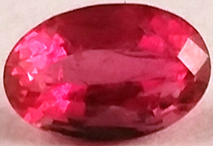User:Tahliafarr/Gemstone
| This is the sandbox page where you will draft your initial Wikipedia contribution.
If you're starting a new article, you can develop it here until it's ready to go live. If you're working on improvements to an existing article, copy only one section at a time of the article to this sandbox to work on, and be sure to use an edit summary linking to the article you copied from. Do not copy over the entire article. You can find additional instructions here. Remember to save your work regularly using the "Publish page" button. (It just means 'save'; it will still be in the sandbox.) You can add bold formatting to your additions to differentiate them from existing content. |
Article Draft
[edit]Lead
[edit]A gemstone (also called a fine gem, jewel, precious stone, semiprecious stone, or simply gem) is a piece of mineral crystal which, in cut and polished form, is used to make jewelry or other adornments. However, certain rocks (such as lapis lazuli, opal, and obsidian) and occasionally organic materials that are not minerals (such as amber, jet, and pearl) are also used for jewelry and are therefore often considered to be gemstones as well. Most gemstones are hard, but some soft minerals are used in jewelry because of their luster or other physical properties that have aesthetic value. Rarity and notoriety are other characteristics that lend value to gemstones.
Found all over the world, the industry of coloured gemstones (this meaning anything other than diamonds) is currently estimated to be around 10-12 million US dollars[1].
Apart from jewelry, from earliest antiquity engraved gems and hardstone carvings, such as cups, were major luxury art forms. A gem expert is a gemologist, a gem maker is called a lapidarist or gemcutter; a diamond cutter is called a diamantaire.
Treatment[edit]
[edit]Gemstones are often treated to enhance the color or clarity of the stone. In some cases, the treatment applied to the gemstone can also increase its durability. Even though natural gemstones can be transformed using the traditional method of cutting and polishing, other treatment options allow the stone's appearance to be enhanced[2]. Depending on the type and extent of treatment, they can affect the value of the stone. Some treatments are used widely because the resulting gem is stable, while others are not accepted most commonly because the gem color is unstable and may revert to the original tone.
An Early History of Gemstone Treatment
Before the innovation of modern day tools, thousands of years ago, people were recorded to use a variety of techniques to treat and enhance gemstones. Some of the earliest methods of gemstone treatment date back to the Minoan Age, for example, foiling, which is where metal foil is used to enhance a gemstone's colour. [3]. Other methods that were recorded 2000 years ago in a book written by C. Plinius Secundus include oiling and dyeing/staining.
Bleaching

Another treatment method that is commonly used to treat gemstones is bleaching. This method uses a chemical in order to reduce the colour of the gem. After bleaching, a combination treatment can be done by dying the gemstone once the unwanted colours are removed. Acid and hydrogen peroxide are among two of the most commonly used products to gemstones and have notably been used to treat jade and pearls. The treatment of bleaching can also be followed by impregnation, which allows the gemstone's durability to be increased [2].
List of rare gemstones[edit]
[edit]- Painite was discovered in 1956 in Ohngaing in Myanmar. The mineral was named in honor of the British gemologist Arthur Charles Davy Pain. In 2005, painite was described by the Guinness Book of World Records as the rarest gem mineral on earth.[page needed]

- Tanzanite was discovered in 1967 in Northern Tanzania. With its supply possibly declining in the next 30 years, this gemstone is considered to be more rare than a diamond. This type of gemstone receives its vibrant blue from being heated [4].
- Hibonite was discovered in 1956 in Madagascar. It was named after the discoverer the French geologist Paul Hibon. Gem quality hibonite has been found only in Myanmar.
- Red beryl or bixbite was discovered in an area near Beaver, Utah in 1904 and named after the American mineralogist Maynard Bixby.
- Jeremejevite was discovered in 1883 in Russia and named after its discoverer, Pawel Wladimirowich Jeremejew (1830–1899).
- Chambersite was discovered in 1957 in Chambers County, Texas, US, and named after the deposit's location.
- Taaffeite was discovered in 1945. It was named after the discoverer, the Irish gemologist Count Edward Charles Richard Taaffe.
- Musgravite was discovered in 1967 in the Musgrave Mountains in South Australia and named for the location

- Black Opal is directly mined in New South Wales, Australia, making it the rarest type of opal. Having a darker composition, this gemstone can be in a variety of colours [4].
- Grandidierite was discovered by Antoine François Alfred Lacroix (1863–1948) in 1902 in Tuléar Province, Madagascar. It was named in honor of the French naturalist and explorer Alfred Grandidier (1836–1912).
- Poudretteite was discovered in 1965 at the Poudrette Quarry in Canada and named after the quarry's owners and operators, the Poudrette family.
- Serendibite was discovered in Sri Lanka by Sunil Palitha Gunasekera in 1902 and named after Serendib, the old Arabic name for Sri Lanka.
- Zektzerite was discovered by Bart Cannon in 1968 on Kangaroo Ridge near Washington Pass in Okanogan County, Washington, USA. The mineral was named in honor of mathematician and geologist Jack Zektzer, who presented the material for study in 1976.
References
[edit]- ^ Belley, Phillippe (2021). "Coloured gemstones: uncharted waters in economic geology". Atlantic Geology. 57.
- ^ a b "An Introduction to Gem Treatments". www.gia.eduhttps. Retrieved 2023-02-21.
- ^ Nassau, Kurt (1984). "The Early History of Gemstone Treatments" (PDF).
- ^ a b "10 Gems Rarer and More Valuable Than Diamonds". The Spruce Crafts. Retrieved 2023-03-31.
